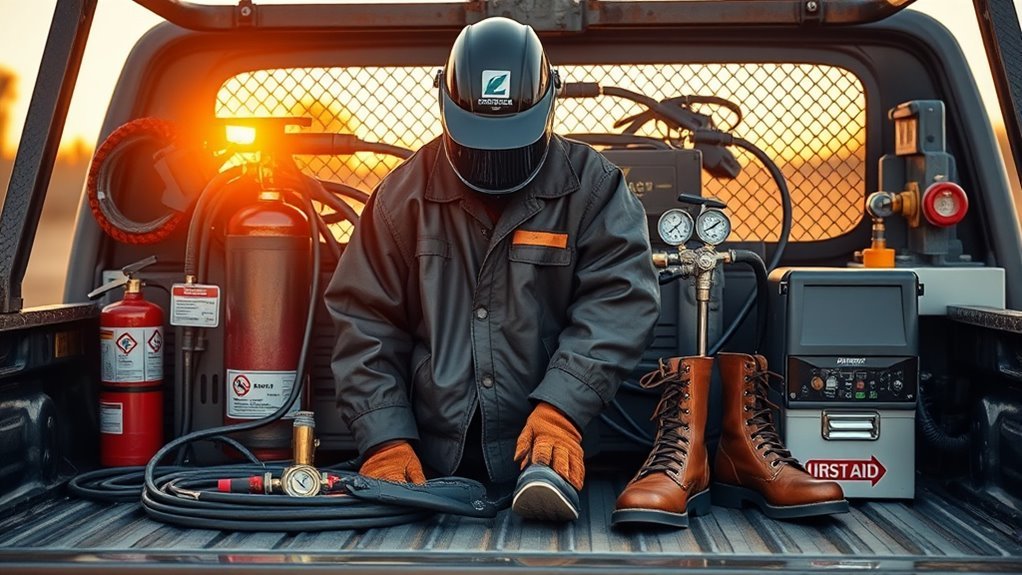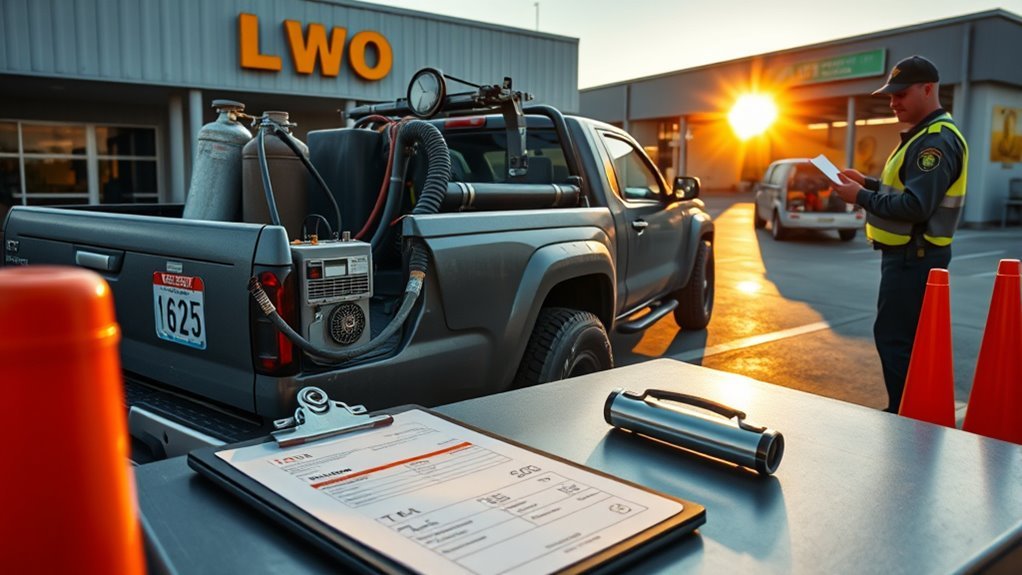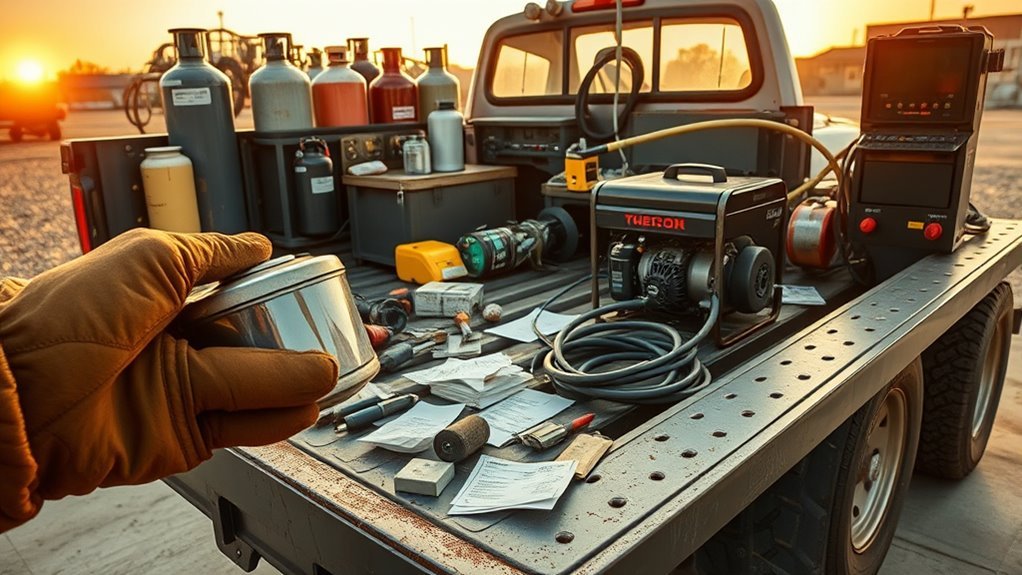About 60% of independent mobile welders invest between $20,000 and $50,000 to outfit a functional rig. You’ll need to balance machine power, generator capacity, and secure mounting to match job types, and small choices now can double costs later. Keep going if you want a clear breakdown of equipment, vehicle modifications, insurance, and operating expenses so you can budget to your workload and avoid costly surprises.
Estimating Total Startup Costs for a Welding Rig

Start by budgeting realistically: a complete welding rig normally falls between $10,000 and $50,000+ depending on the welder type, ancillary tools, and the vehicle you mount it in.
You’ll itemize capital outlays: basic toolset (welder, bottles, grinders, compressor) typically runs $5,000–$15,000; a reliable vehicle adds $20,000–$80,000 based on condition and specs.
Include mandatory annual costs—insurance often averages ~$12,000—to avoid cash-flow shocks. Factor consumables and preventive maintenance into recurring operating costs; these can erode margins if omitted.
For practical startup budget development, create line-item estimates, assign contingency (10–15%), and project first-year burn rate separately from capital purchases.
Use this as the core of your financial planning: compare best- and worst-case totals, then validate against expected revenue cadence.
You’ll then have a defensible ask for financing or a clear payback timeline before committing to purchases or vehicle acquisition.
Essential Welding Machines and Generators

Having laid out the budget framework and recurring costs, you now need to specify the core machines and power sources that will determine both capability and cash requirements.
Choose your welding rig types based on intended work: a portable welder ($1,500–$5,000) covers basic stick/MIG/TIG needs, while industrial rigs push costs higher. For off-grid or mobile operation, match generator capacity to welder draw; reliable generator brands run $1,000–$3,500 depending on continuous kW and surge capability.
Factor in complementary machines: plasma cutters and band saws add $1,000–$5,000 based on cut quality and duty cycle. Safety gear is essential but separate from tools: plan $300–$1,000 for helmets, gloves, and clothing.
These items collectively place a functional rig in the $5,000–$20,000+ range. Prioritize duty cycle, output stability, and serviceability when selecting machines and generator brands to optimize uptime and lifecycle cost.
Required Tools, Consumables, and Spare Parts

You’ll need a core set of tools—welder (typically $1,000–$5,000), grinder, plasma cutter—and precise consumables like rods, electrodes, and shielding gas sized to your process.
Plan annual consumable and spare budgets ($500–$1,500 for consumables; $200–$800 for hoses, regulators, tips) to avoid downtime.
Factor tool quality (an extra $500–$3,000 for premium grinders/cutters) into your total rig cost estimate of roughly $5,000–$20,000+.
Essential Welding Tools
Because the right tools determine both capability and cost, plan your rig around a primary welder, reliable gas bottles, grinders, and a small inventory of consumables and spares.
Choose a welder matched to your welding techniques — MIG/TIG/stick — with budgets typically $1,500–$10,000.
Budget gas bottles at about $200 each and grinders at $100–$400 for cutting and surface prep.
Add safety gear (helmets, gloves, clothing) for $100–$500.
Consider supplementary equipment: plasma cutters, band saws, and compressors (compressors commonly $500–$2,500) to expand capability.
Track equipment maintenance costs and expected replacement intervals for nozzles, tips, and hoses, which average $50–$150 per part.
Prioritize durable core tools to minimize downtime and lower long-term operating costs.
Consumables and Spares
Consumables and spares are the heartbeat of a welding rig, and you’ll want to budget for their regular replacement rather than treat them as one-time costs. You’ll track consumable types — welding rods, filler wire, shielding gas, contact tips, and PPE — and project annual spend; experienced shops cite roughly $1,000 for basic supplies, though costs vary by process.
Keep critical spare parts on hand: hoses, regulators, connectors, and replacement leads to prevent downtime. Prioritize quality for items under mechanical or thermal stress to improve reliability and safety. Allocate a rotating stock and a small contingency fund for unexpected failures.
Regular inventory audits and consumption monitoring let you forecast purchases and optimize total operating cost.
Vehicle, Storage, and Rig Mounting Expenses

One major cost driver is the vehicle choice, which can span from about $12,500 for a used 2009 Chevy 3500 to upwards of $80,000 for a new 2024 Chevy 3500 fitted as a complete rig.
Your vehicle selection determines payload, towing, and space for built-in storage solutions. Plan for mounting hardware, toolboxes, and brackets — these add several thousand dollars and must align with weight-distribution requirements.
- Vehicle selection: choose chassis by payload and GVWR; heavier-duty trucks cost more but reduce suspension and brake upgrades.
- Storage solutions: modular racks, lockable boxes, and drawer systems optimize portable welders and tooling while minimizing movement and access time.
- Mounting and integration: factor engineered mounts, reinforced subframes, and fasteners; proper mounting guarantees compliance with transport regulations and safer on-site operation.
Expect total initial investment from roughly $20,000 for a minimal setup to over $80,000 for a fully integrated, compliant mobile welding rig.
Safety Gear, PPE, and Compliance Costs

When you outfit a welding rig, plan for an upfront PPE package of roughly $300–$1,000 per operator—covering auto-darkening helmets, respirators, leather gloves, FR jackets/pants, and safety boots—and budget for recurring replacement cycles (helmets filters, gloves, respirator cartridges) every 6–24 months.
You’ll also factor in costs for mandated training and certifications, typically $200–$1,500 per welder, to meet safety regulations and document competence.
Routine gear maintenance, inspection, and calibration (respirator fit-testing, helmet sensor checks) reduce failure risk but add expense; expect annual inspection/audit fees from $500 to several thousand depending on rig scale.
Purchase higher-quality consumables to lower replacement frequency, balance that against capital outlay, and maintain a predictable lifecycle schedule for PPE inventory.
Track service records and replacement intervals to demonstrate compliance during audits.
This practical, technical approach helps you control ongoing PPE expenditure, minimize downtime from gear failures, and guarantee your operation adheres to applicable safety regulations and gear maintenance standards.
Insurance, Licensing, and Regulatory Fees

Because welding work carries high liability and regulatory exposure, you should budget for mandatory insurance, licences, and fees as core operating costs.
You’ll typically need minimum liability coverage of $1M (some clients require $2M). Annual insurance costs average about $12,000 and cover vehicle, contents, well-head, and hot tie-in exposures.
Independent welders must carry their own liability and worker’s compensation; split-check welders rely on contractor insurance.
Know local regulations and company policies — they dictate licensing, employment classification, and acceptable insurance options.
- Liability and WC: Maintain at least $1M liability and state-required worker’s compensation; expect higher limits per client specs.
- Licensing and permits: Budget for local business licences, professional welding endorsements, and permit fees tied to site access and hot-work permits.
- Contractual requirements: If you’re a contract welder, plan to supply your own insurance and consumables; verify contractor insurance when working split-check to guarantee regulatory compliance.
Ongoing Operating and Maintenance Costs

Plan on several predictable monthly outlays and a few variable ones when budgeting for ongoing operating and maintenance costs.
You’ll face fuel expenses that vary by location and usage, so implement fuel management practices — route planning, idle reduction, and tracking — to constrain that line item.
Consumables (rods, shielding gas, tips) can total several thousand dollars annually; quantify usage per project and price accordingly.
Consumables — rods, shielding gas, tips — often add up to several thousand dollars yearly; track usage and price per project.
Insurance and liability coverage commonly run near $12,000 a year, a fixed cost you must include.
Schedule preventive maintenance for the engine, generator, wire feeders, and leads; documented maintenance strategies reduce failure rates and unplanned repair costs.
Anticipate periodic parts replacement and occasional equipment repairs, and set a repair reserve equivalent to a percentage of annual revenue.
Because work volume fluctuates, maintain a cash buffer to cover operating expenses during slow periods.
Track all operating expenditures monthly to refine budgets and protect margins.
Financing Options and Cost-Saving Strategies

You can ease upfront expense by using low-cost financing routes like equipment loans, leasing, or targeted personal loans that spread payments and often offer better rates than credit cards.
Stretching dollars further means buying used or entry-level welders and prioritizing essential safety gear while postponing noncritical accessories.
Also consider union discounts and staged upgrades to preserve cash flow and reduce total cost of ownership.
Low-Cost Financing Routes
When cash is tight, exploring low-cost financing routes—like personal loans, credit-union lines of credit, equipment financing, or vendor payment plans—lets you spread the cost of a welding rig into manageable monthly payments without depleting working capital.
Use budget friendly loans and alternative financing to match term, rate, and tax treatment to your cash flow. Assess total interest, fees, and collateral requirements before signing.
- Compare credit-union lines and personal loans for lower rates and flexible repayment.
- Use equipment financing or vendor plans to preserve capital; equipment can act as collateral.
- Investigate government grants, local small-business programs, and peer networks for low-interest or subsidized options.
Build a concise budget projecting equipment cost, payments, and expected earnings.
Smart Gear Cost-Saving
Although financing can ease upfront strain, prioritize essential, multi‑function gear and consider used components to cut initial outlay by 20–50% while keeping capability.
You can use equipment loans (5–10% interest) to spread costs for higher‑cost machines, but size payments to cash flow. Start with core items and phase in upgrades; multi‑function tools lower cumulative capital and maintenance.
Scan smart gear reviews and verified resale listings to verify condition and avoid obsolete models. Join welding forums to access group buys, shared tooling, and practical buying checklists that reduce wasteful purchases.
Track total cost of ownership—consumables, calibration, expected lifespan—so financing decisions reflect real operating cost, not just purchase price. Prioritize modular, repairable, innovative tools.
Projecting Return on Investment and Break-Even Timeline

Because your upfront cost directly shapes profitability, projecting ROI starts with a clear tally of total investment—purchase price, outfitting, and any financing—then compares that to realistic revenue and recurring operating expenses.
Use return projections that factor purchase ranges ($12,500–$80,000) and annual operating costs (≈$12,000). Build scenarios: conservative, expected, and aggressive based on utilization and pricing.
- Calculate baseline: total cost / (hourly rate × weekly hours × utilization) to estimate months to break even; e.g., $20,000 / ($100 × 40 × 0.9) ≈ 5 months.
- Stress-test for income fluctuations: model 25–50% revenue drop periods and guarantee reserve funds cover operating fixed costs for that duration.
- Optimize ROI: reduce discretionary outfitting, target jobs matching the rig, and monitor fuel/consumable spend to shorten payback.
Update projections quarterly; track actuals against models and adjust pricing, scheduling, or costs to protect margin and speed break-even.
Frequently Asked Questions
How Do Seasonal Fuel Price Changes Affect Running Costs?
Seasonal fluctuations raise your running costs when fuel price trends spike, forcing higher per-hour operating expenses and increased maintenance scheduling; you’ll need predictive budgeting, fuel hedging, and efficiency tuning to minimize volatility’s technical and practical impact.
Can I Convert an Existing Vehicle Into a Rig Affordably?
Yes — you can convert an existing vehicle into a rig affordably if you plan carefully. Perform a vehicle modifications cost breakdown, prioritize structural mounts, power supply, ventilation, and safety gear, and source used components to minimize expenses.
What Warranties Typically Cover Welding Equipment Failures?
Most warranties cover defects, parts, and limited labor; you’ll get coverage terms tied to equipment lifespan, prorated or full for specific components, and optional extended plans that cover wear, electronic failures, and consumable exclusions.
How Much Training Will My Crew Need for Advanced Welders?
About 60–120 hours per welder is typical; studies show certified welders reduce defects by 40%. You’ll need welding certifications aligned to code, targeted skills training, and mentoring to build crew experience and guarantee consistent quality.
Are There Tax Incentives for Mobile Welding Businesses?
Yes — you can claim tax deductions for eligible business expenses like mobile equipment, vehicle costs, tools, and training; you’ll need detailed records, consult a tax professional, and follow federal and state rules to maximize compliant deductions.
Conclusion
You’ll likely invest $20,000–$80,000 to build a functional welding rig, depending on equipment quality, vehicle choice, and compliance needs. Prioritize a reliable welder and generator, essential tools, PPE, and secure mounting; budget for insurance, licensing, and maintenance. Use financing or leasing to spread costs, and keep a contingency fund. Track expenses and utilization to project ROI and breakeven—think like a Tudor merchant: meticulous records and practical efficiency win.


